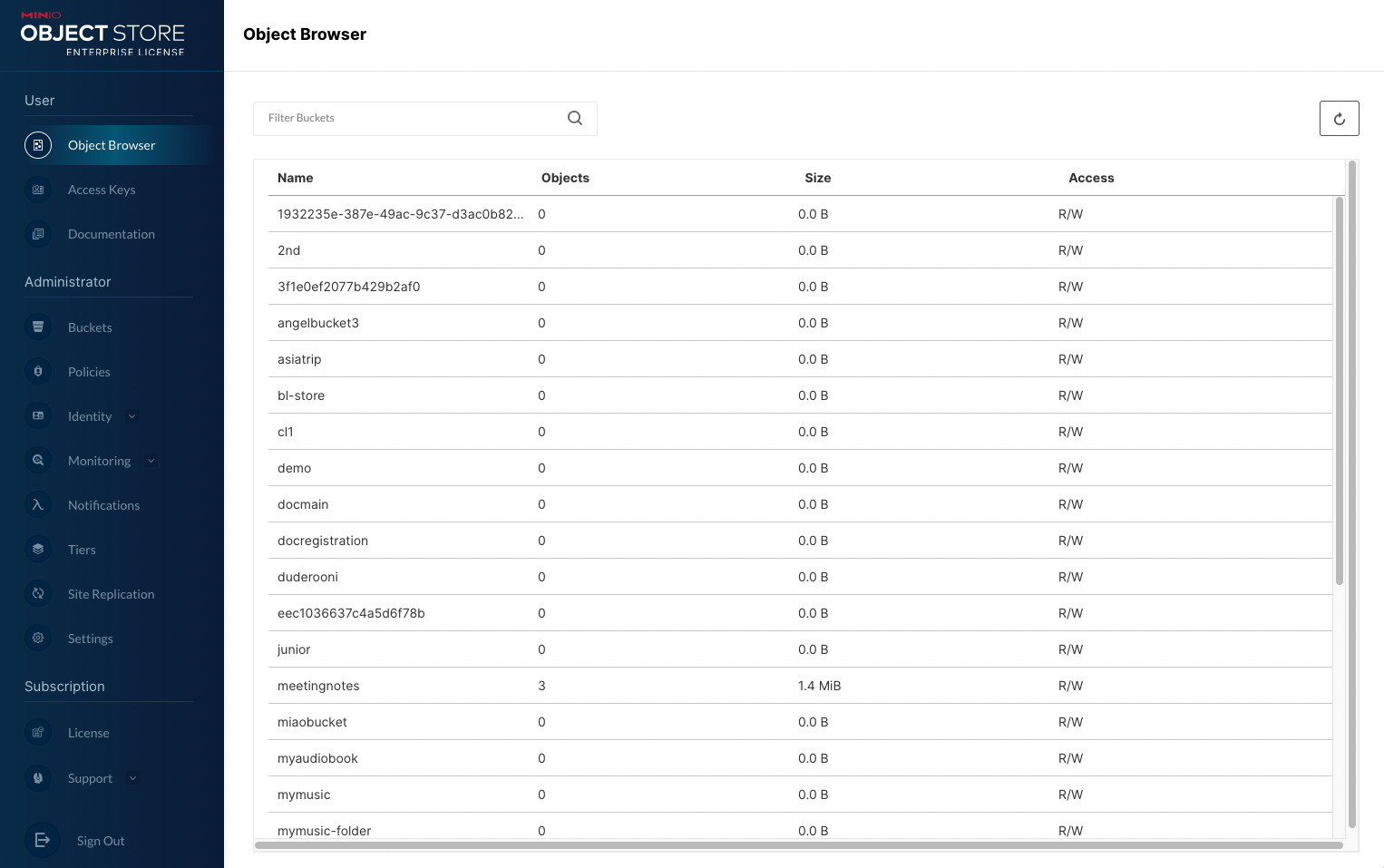Deploy MinIO on Windows
This page documents deploying MinIO onto Microsoft Windows hosts.
MinIO officially supports Windows operating systems in the Active Support of the Microsoft Modern Lifecycle Policy.
At the time of writing, that includes:
Windows Server 23H2 (Recommended)
Windows Server 2022 LTSC
Windows 11 Enterprise/Workstation 23H2
Windows 11 Enterprise/Workstation 22H2
Windows 10 Enterprise 21H2 (LTS)
Windows 10 IoT 21H2 (LTS)
Windows 10 Enterprise 22H2
MinIO may run on older or out-of-support Windows releases, with limited support or troubleshooting from either MinIO or Microsoft.
The procedure includes guidance for deploying Single-Node Multi-Drive (SNMD) and Single-Node Single-Drive (SNSD) topologies in support of early development and evaluation environments.
MinIO does not officially support Multi-Node Multi-Drive (MNMD) “Distributed” configurations on Windows hosts.
Considerations
Review Checklists
Ensure you have reviewed our published Hardware, Software, and Security checklists before attempting this procedure.
Erasure Coding Parity
MinIO automatically determines the default erasure coding configuration for the cluster based on the total number of nodes and drives in the topology.
You can configure the per-object parity setting when you set up the cluster or let MinIO select the default (EC:4 for production-grade clusters).
Parity controls the relationship between object availability and storage on disk. Use the MinIO Erasure Code Calculator for guidance in selecting the appropriate erasure code parity level for your cluster.
While you can change erasure parity settings at any time, objects written with a given parity do not automatically update to the new parity settings.
Procedure
1. Download the MinIO Binary
Download the MinIO executable from the following URL:
https://dl.min.io/server/minio/release/windows-amd64/minio.exe
The next step includes instructions for running the executable. You cannot run the executable from the Explorer or by double clicking the file. Instead, you call the executable to launch the server.
2. Launch the MinIO Server
In PowerShell or the Command Prompt, navigate to the location of the executable or add the path of the minio.exe file to the system $PATH.
computer.
For Windows hosts with multiple drives, you can specify a sequential set of drives to use for configuring MinIO in the Single-Node Multi-Drive (SNMD) topology:
.\minio.exe server {D...G}:\minio --console-address :9001
The minio server process prints its output to the system console, similar to the following:
API: http://192.0.2.10:9000 http://127.0.0.1:9000
RootUser: minioadmin
RootPass: minioadmin
Console: http://192.0.2.10:9001 http://127.0.0.1:9001
RootUser: minioadmin
RootPass: minioadmin
Command-line: https://min.io/docs/minio/linux/reference/minio-mc.html
$ mc alias set myminio http://192.0.2.10:9000 minioadmin minioadmin
Documentation: https://min.io/docs/minio/linux/index.html
WARNING: Detected default credentials 'minioadmin:minioadmin', we recommend that you change these values with 'MINIO_ROOT_USER' and 'MINIO_ROOT_PASSWORD' environment variables.
The process is tied to the current PowerShell or Command Prompt window. Closing the window stops the server and ends the process.
Use this command to start a local MinIO instance in the C:\minio folder.
You can replace C:\minio with another drive or folder path on the local
.\minio.exe server C:\minio --console-address :9001
The minio server process prints its output to the system console, similar to the following:
API: http://192.0.2.10:9000 http://127.0.0.1:9000
RootUser: minioadmin
RootPass: minioadmin
Console: http://192.0.2.10:9001 http://127.0.0.1:9001
RootUser: minioadmin
RootPass: minioadmin
Command-line: https://min.io/docs/minio/linux/reference/minio-mc.html
$ mc alias set myminio http://192.0.2.10:9000 minioadmin minioadmin
Documentation: https://min.io/docs/minio/linux/index.html
WARNING: Detected default credentials 'minioadmin:minioadmin', we recommend that you change these values with 'MINIO_ROOT_USER' and 'MINIO_ROOT_PASSWORD' environment variables.
The process is tied to the current PowerShell or Command Prompt window. Closing the window stops the server and ends the process.
3. Connect your Browser to the MinIO Server
Access the MinIO Console by going to a browser (such as Microsoft Edge) and going to http://127.0.0.1:9001 or one of the Console addresses specified in the minio server command’s output.
For example, Console: http://192.0.2.10:9001 http://127.0.0.1:9001 in the example output indicates two possible addresses to use for connecting to the Console.
While port 9000 is used for connecting to the API, MinIO automatically redirects browser access to the MinIO Console.
Log in to the Console with the RootUser and RootPass user credentials displayed in the output.
These default to minioadmin | minioadmin.

You can use the MinIO Console for general administration tasks like Identity and Access Management, Metrics and Log Monitoring, or Server Configuration. Each MinIO server includes its own embedded MinIO Console.

For more information, see the MinIO Console documentation.
4. (Optional) Install the MinIO Client
The MinIO Client allows you to work with your MinIO deployment from Powershell.
Download the standalone MinIO client for Windows from the following link:
https://dl.min.io/client/mc/release/windows-amd64/mc.exe
Double click on the file to run it. Or, run the following in the Command Prompt or PowerShell.
\path\to\mc.exe --help
Use mc.exe alias set to quickly authenticate and connect to the MinIO deployment.
mc.exe alias set local http://127.0.0.1:9000 minioadmin minioadmin
mc.exe admin info local
The mc.exe alias set takes four arguments:
The name of the alias
The hostname or IP address and port of the MinIO server
The Access Key for a MinIO user
The Secret Key for a MinIO user
For additional details about this command, see mc alias set.
5. Next Steps
ToDo